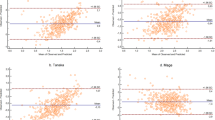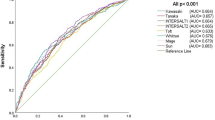Abstract
Objectives:
Accurate estimation of sodium intake by a precise and reproducible method is crucial in sodium intake reduction policy. This study tested the feasibility of 24-h urine (24HU) collection method and estimated sodium intake of a major city population from a representative adult sample.
Subjects/methods:
A representative population (aged 20–65 years) was selected by list-assisted random-digit dialing method from a city with a population of one million. Sodium and potassium intakes (24HUNa and 24HUK, respectively) were measured with 24HU collection.
Results:
Of those 496 individuals recruited, 24HU samples from 368 participants were determined to be properly collected and analyzed. The weighted mean of 24HUNa was 166.4±68.1 mmol per day, much lower than 208.2 mmol of 24HUNa measured in Pusan (Korea; 1988 INTERSALT). The 24HUNa was highest in population aged 40–49 years, with a decrease after 50 years. Men had higher 24HUNa than women (182.0±77.6 vs 151.4±55.0 mmol per day). The sodium intake is higher than that found in survey conducted in the United Kingdom/Scotland and Finland, similar to that of Spain and lower than that of Portugal, Slovenia and Turkey. In contrast to 24HUNa, 24HUK increased continuously as age increased.
Conclusions:
This study enables us to compare sodium intake with the results of other surveys even from other countries, and reinforce the recommended introduction of the 24HU collection method in Korea. Sodium intake of the studied population was higher than the World Health Organization recommendation, suggesting the needs for further efforts to reduce sodium intake.
This is a preview of subscription content, access via your institution
Access options
Subscribe to this journal
Receive 12 print issues and online access
$259.00 per year
only $21.58 per issue
Buy this article
- Purchase on Springer Link
- Instant access to full article PDF
Prices may be subject to local taxes which are calculated during checkout
Similar content being viewed by others
References
Brown IJ, Tzoulaki I, Candeias V, Elliott P . Salt intakes around the world: implications for public health. Int J Epidemiol 2009; 38: 791–813.
Strazzullo P, D’Elia L, Kandala NB, Cappuccio FP . Salt intake, stroke, and cardiovascular disease: meta-analysis of prospective studies. BMJ 2009; 339: b4567.
Sacks FM, Svetkey LP, Vollmer WM, Appel LJ, Bray GA, Harsha D et al. Effects on blood pressure of reduced dietary sodium and the Dietary Approaches to Stop Hypertension (DASH) diet. DASH-Sodium Collaborative Research Group. N Engl J Med 2001; 344: 3–10.
Chen J, Gu D, Huang J, Rao DC, Jaquish CE, Hixson JE et al. Metabolic syndrome and salt sensitivity of blood pressure in non-diabetic people in China: a dietary intervention study. Lancet 2009; 373: 829–835.
He FJ, MacGregor GA . A comprehensive review on salt and health and current experience of worldwide salt reduction programmes. J Hum Hypertens 2009; 23: 363–384.
Karppanen H, Mervaala E . Sodium intake and hypertension. Prog Cardiovasc Dis 2006; 49: 59–75.
Pietinen P, Vartiainen E, Seppanen R, Aro A, Puska P . Changes in diet in Finland from 1972 to 1992: impact on coronary heart disease risk. Prev Med 1996; 25: 243–250.
World Health Organization. Reducing Salt Intake in Populations. Report of a WHO Forum and Technical Meeting. World Health Organization: Paris, France, 2007.
Kim SWLS, Hong SJ, Park SH . List-assisted RDD sampling in Korea: testing the feasibility of national survey under within-household selection. Int J Pub Opin Res 2012; 24: 79–92.
Knuiman JT, Hautvast JG, van der Heyden L, Geboers J, Joossens JV, Tornqvist H et al. A multi-centre study on completeness of urine collection in 11 European centres. I. Some problems with the use of creatinine and 4-aminobenzoic acid as markers of the completeness of collection. Hum Nutr Clin Nutr 1986; 40: 229–237.
Murakami K, Sasaki S, Takahashi Y, Uenishi K, Watanabe T, Kohri T et al. Sensitivity and specificity of published strategies using urinary creatinine to identify incomplete 24-h urine collection. Nutrition 2008; 24: 16–22.
Rabi DM, Daskalopoulou SS, Padwal RS, Khan NA, Grover SA, Hackam DG et al. The 2011 Canadian Hypertension Education Program recommendations for the management of hypertension: blood pressure measurement, diagnosis, assessment of risk, and therapy. Can J Cardiol 2011; 27: 415–433.
Laatikainen T, Pietinen P, Valsta L, Sundvall J, Reinivuo H, Tuomilehto J . Sodium in the Finnish diet: 20-year trends in urinary sodium excretion among the adult population. Eur J Clin Nutr 2006; 60: 965–970.
Polonia J, Maldonado J, Ramos R, Bertoquini S, Duro M, Almeida C et al. Estimation of salt intake by urinary sodium excretion in a Portuguese adult population and its relationship to arterial stiffness. Rev Port Cardiol 2006; 25: 801–817.
Scottish Centre for Social Research. A Survey of 24 hour Urinary Sodium Excretion in a Representative Sample of the Scottish Population as a Measure of Salt Intake. National Centre for Social Research: London UK,, 2011.
National Centre for Social Research. An assessment of dietary sodium levels among adults (aged 19–64) in the UK general population in 2008, based on analysis of dietary sodium in 24 hour urine samples. National Centre for Social Research:. London, UK, 2008.
Ortega RM, Lopez-Sobaler AM, Ballesteros JM, Perez-Farinos N, Rodriguez-Rodriguez E, Aparicio A et al. Estimation of salt intake by 24 h urinary sodium excretion in a representative sample of Spanish adults. Br J Nutr 2011; 105: 787–794.
Ribic CH, Zakotnik JM, Vertnik L, Vegnuti M, Cappuccio FP . Salt intake of the Slovene population assessed by 24 h urinary sodium excretion. Public Health Nutr 2010; 13: 1803–1809.
Erdem Y, Arici M, Altun B, Turgan C, Sindel S, Erbay B et al. The relationship between hypertension and salt intake in Turkish population: SALTURK study. Blood Press 2010; 19: 313–318.
Intersalt Cooperative Research Group. Intersalt: an international study of electrolyte excretion and blood pressure. Results for 24 hour urinary sodium and potassium excretion. BMJ 1988; 297: 319–328.
Stamler J PE, Chan Q, for the INTERMAP Research Group. INTERMAP Appendix Tables, Tables of Contents (Tables A). J Hum Hypertens 2003; 17: 665–758.
Yoshita K, Miura K, Okayama A, Okuda N, Schakel SF, Dennis B et al. A validation study on food composition tables for the international cooperative INTERMAP study in Japan. Environ Health Prev Med 2005; 10: 150–156.
Kwon YJ, Rhee MY, Kim JY, Kwon KI, Kim SJ, Shin HJ et al. Differences between analyzed and estimated sodium contents of food composition table or food exchange list. J Korean Soc Food Sci Nutr 2010; 39: 535–541.
Holbrook JT, Patterson KY, Bodner JE, Douglas LW, Veillon C, Kelsay JL et al. Sodium and potassium intake and balance in adults consuming self-selected diets. Am J Clin Nutr 1984; 40: 786–793.
Kirby CR, Convertino VA . Plasma aldosterone and sweat sodium concentrations after exercise and heat acclimation. J Appl Physiol 1986; 61: 967–970.
Ogawa M . Feasibility of overnight urine for assessing dietary intakes of sodium, potassium, protein and sulfur amino acids in field studies. Jpn Circ J 1986; 50: 595–600.
Kawasaki T, Itoh K, Uezono K, Sasaki H . A simple method for estimating 24 h urinary sodium and potassium excretion from second morning voiding urine specimen in adults. Clin Exp Pharmacol Physiol 1993; 20: 7–14.
Wesson LG Jr . Electrolyte excretion in relation to diurnal cycles of renal function. Medicine (Baltimore, MD) 1964; 43: 547–592.
Dyer AR, Martin GJ, Burton WN, Levin M, Stamler J . Blood pressure and diurnal variation in sodium, potassium, and water excretion. J Hum Hypertens 1998; 12: 363–371.
Lykken GI, Jacob RA, Munoz JM, Sandstead HH . A mathematical model of creatine metabolism in normal males—comparison between theory and experiment. Am J Clin Nutr 1980; 33: 2674–2685.
Forbes GB, Bruining GJ . Urinary creatinine excretion and lean body mass. Am J Clin Nutr 1976; 29: 1359–1366.
Bingham S, Cummings JH . The use of 4-aminobenzoic acid as a marker to validate the completeness of 24 h urine collections in man. Clin Sci (Lond) 1983; 64: 629–635.
Henderson L, Irving K, Gregory J, Bates CJ, Prentice A, Perks J, Swan G et al. The National Diet & Nutrition Survey: adults aged 19 to 64 years. in: Vitamin and Mineral Intake and Urinary Analytes. The Stationery Office: London, UK, 2003.
Kim HJ, Paik HY, Lee SY, Shim JE, Kim YS . Salt usage behaviors are related to urinary sodium excretion in normotensive Korean adults. Asia Pac J Clin Nutr 2007; 16: 122–128.
Kim BK, Lim YH, Kim SG, Kim YM, Shin J . Relationship between sodium intake and blood pressure according to metabolic syndrome status in the Korean National Health and Nutrition Examination Survey. Blood Press Monit 2012; 17: 120–127.
Lee JS, Park J, Kim J . Dietary factors related to hypertension risk in Korean adults—data from the Korean National Health and Nutrition Examination Survey III. Nutr Res Pract 2011; 5: 60–65.
Park J, Lee JS, Kim J . Relationship between dietary sodium, potassium, and calcium, anthropometric indexes, and blood pressure in young and middle aged Korean adults. Nutr Res Pract 2010; 4: 155–162.
Fahimi M, Kulp D, Brick JM . Bias in RDD sampling: a 21th century digital world reassessment. Annual Conference of the American Association for Public Opinion Research. New Orleans, LA, USA, 2008.
Siegfried Gabler SH . Idiosyncrasies in telephone sampling—the case of Germany. Int J Public Opin Res 2002; 14: 339–345.
Gerry Nicolaas PL . Random-digit dialing in the UK: viability revisited. J R Statisti Soc Ser A 2002; 165: 297–316.
Noble I, Moon N, McVey D . Bringing it all back home: using RDD telephone methods for large-scale social policy and opinion research in the UK. J Mark Res Soc 1998; 40: 93–120.
Korean Center of Disease Control and Prevention. Korean National Health and Nutrition Examination Surveys: The Fourth Surveys. Korean Center of Disease Control and Prevention, Ministry of Health and Welfare: Seoul,, 2009.
D’Elia L, Barba G, Cappuccio FP, Strazzullo P . Potassium intake, stroke, and cardiovascular disease a meta-analysis of prospective studies. J Am Coll Cardiol 2011; 57: 1210–1219.
Dickinson HO, Nicolson DJ, Campbell F, Beyer FR, Mason J . Potassium supplementation for the management of primary hypertension in adults. Cochrane Database Syst Rev 2006; 19: CD004641.
Whelton PK, He J, Cutler JA, Brancati FL, Appel LJ, Follmann D et al. Effects of oral potassium on blood pressure. Meta-analysis of randomized controlled clinical trials. JAMA 1997; 277: 1624–1632.
Acknowledgements
This research was supported by a grant (11162KFDA162) from the Korea Food and Drug Administration in 2011.
Author information
Authors and Affiliations
Corresponding author
Ethics declarations
Competing interests
The authors declare no conflict of interest.
Rights and permissions
About this article
Cite this article
Rhee, MY., Shin, SJ., Park, SH. et al. Sodium intake of a city population in Korea estimated by 24-h urine collection method. Eur J Clin Nutr 67, 875–880 (2013). https://doi.org/10.1038/ejcn.2013.87
Received:
Revised:
Accepted:
Published:
Issue Date:
DOI: https://doi.org/10.1038/ejcn.2013.87
Keywords
This article is cited by
-
Association between the transtubular potassium gradient and progression of chronic kidney disease: results from KNOW-CKD
Journal of Nephrology (2021)
-
2018 Korean Society of Hypertension Guidelines for the management of hypertension: part II-diagnosis and treatment of hypertension
Clinical Hypertension (2019)
-
Relationship between 24-h urine sodium/potassium ratio and central aortic systolic blood pressure in hypertensive patients
Hypertension Research (2017)



